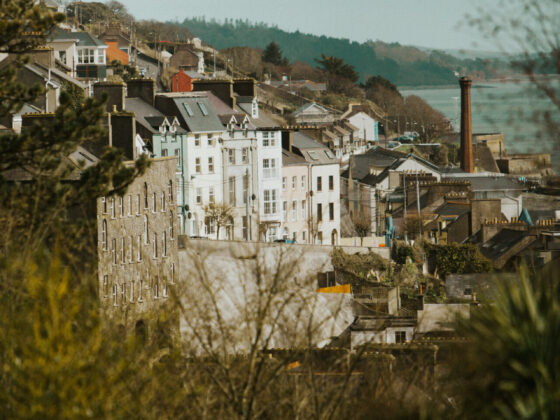We were vacationing with friends at the beach when we found out we were pregnant with our third child. Our five-year-old son ran out of our bedroom holding a positive pregnancy test while we adults sipped coffee looking out at the ocean from the balcony. “Mom,” he asked, “what does it say? Are we having a baby?” I stole a glance at my husband, my deep delight bubbling up in laughter, and announced that, yes, we were having a baby. We laughed with our friends about the anti-fussiness of our announcement, made minutes after our own discovery of this sacred, beautiful life—no balloons or onesies or “World’s Best Dad” coffee mugs. It was, after all, our third pregnancy. My body had already carried two beautiful boys through uncomplicated, healthy pregnancies and we were confident in its ability to do it again.
The following morning, I sat with my dear friend and pondered the mysterious beauty of pregnancy. “It’s the most godly experience I’ve ever had,” I told her, “the feeling of holding extra life within my body. I wonder if the feeling of pregnancy is what the Trinity felt right before creation; like there was so much life between them that there was nothing to do but allow it to flow through and beyond them.” I walked on a mostly-empty December beach, searching for pink shells as a sign from God that we’d have a daughter, or a double shell to signify twins. We gave our parents tiny onesies with an embroidered “3” on the front for Christmas and celebrated the new year with great anticipation of ending the year as a family of five.
Then, in the middle of January, I found myself typing “Can you miscarry without knowing?” into my search bar, sensing something had gone wrong. The next afternoon, I laid on a sheet of crinkly paper atop a plastic examination table and saw an undeveloped fetal pole whose heart had stopped beating weeks before. “I am so sorry,” the ultrasound technician said, with tears in her own eyes.
I carried the body of our baby for another three weeks before they passed through me in the early hours of a cold February morning. Those weeks were some of the most profoundly painful and confusing of my life—how was I to live as usual with a corpse inside of me? How was I to live while I carried death in my body? What did this brutal reversal of my own expectations say about the purpose and character of God?
Perhaps the deepest sadness of that time (aside from the sheer gravity of losing our beloved child) came in the realization that I wouldn’t get to experience the immense glory and joy of sharing in God’s role as creator of life. I’d spent the weeks between the beach and the doctor’s table pondering that beautiful mystery, one I’d embodied twice before. Carrying a new life had been, for me, the singular most transformative experience in my own faith; the circumstance through which I’d learned and believed the power and intimacy of God most clearly. It was by embodying the glorious mystery of divine creativity that Genesis 1 and 2 started to make sense. Pregnancy had been my closest experience of Eden: the organic expansion of life and love in the presence of God—the way it was meant to be.
As It Was & As It Will Be: God’s Design for Life in the Beginning and Eternity to Come
In the beginning, the three members of the divine community decided to allow the infinite love and life between them to expand beyond them. From their abundance came sun and stars, trees and otters, breeze and the bird’s song. The crown jewel of creation, the fullest expression of the abundant life and love of God, was man and woman. And in God’s infinite kindness, he allowed his prized creation to embody the pattern of life-by-love through the gifts of sex, pregnancy, and birth. The union of souls and bodies in the sacred act of physical intimacy is not merely a gift of pleasure: it is a gift of being like God—fully with another, the love and life of two bodies mingling to create more of itself: more life, more love. And it all begins in the womb of woman.
The Sacred Womb
In the Scriptures, the womb is used as a metaphor for God’s blessing and intimate presence with his people. In Psalm 139, the womb is pictured as the place where God’s very hands knit our bodies together from a formless, holy idea. The womb is a space of deep vulnerability for both baby and mother. But in the way that God meant it to be, the womb is a space of deep intimacy and communion. The invisibility of a child within us, known only by their body’s effect on our own, mirrors the invisible Spirit of God at work within and around us. The process of knowing and loving an unseen other is, by definition, an exercise of faith, one that requires enormous risk. But that risk only exists because the outcome in our fallen world is unsure. This has not always been the case. Before the fall in Genesis 3, death did not exist, so fear of death would have been futile—who would fear an outcome that had never before occurred? And the blessing of conception and childbirth remains even in the midst of our sin-ridden reality. Even after the fall of Genesis 3, the bearing of children is the means by which God increases Israel from a single man into a nation. But in Eden, pregnancy always ended in a beautiful birth, and the life that emerged would have lasted forever.
Longing For Eden
It is good and right for this thought to stir a longing in us—Oh, that it would be so today, Lord! That we’d never again suffer the silent sonogram! That we’d never again bury a baby whose eyes never opened! These longings are holy and will be satisfied and sustained forever by God:
“I heard a loud shout from the throne, saying, ‘Look, God’s home is now among his people! He will live with them, and they will be his people. God himself will be with them. He will wipe every tear from their eyes, and there will be no more death or sorrow or crying or pain. All these things are gone forever.’”
Revelation 21:3-4 NLT
The way it was meant to be will be the way it is on the day of the Lord; it will remain so for eternity. God will dwell, once again, with us in the gardens of the new earth. Our bodies will not die, and neither will those of our children. The fear of death will be relegated to its intended futility. God assures us of its hope himself, saying:
“And the one sitting on the throne said, ‘Look, I am making everything new!’ And then he said to me, ‘Write this down, for what I tell you is trustworthy and true.’”
Revelation 21:5 NLT
One day soon, our bodies will hold pure, unadulterated, holy vitality for which they were created. This is the hope to which we cling between Eden and Glory. This hope can and should create in us a deep sense of peace and joyful expectation. But hope can only get us so far while we wait, holding death in our bodies, burying children we never got to know.
As It Is
Today we live in the space between Genesis 2 and Revelation 21. We are bolstered by our knowledge of God’s intended design for life and love and his promise to restore all things in his time, but we are also grieved by its unfulfillment. In many ways, miscarriage is a perfect metaphor for the vast dissimilarity we see between Genesis 2 (as it was meant to be) to Genesis 3 (our current fallen reality). Life, as God intended, began by love, was harbored in the womb, was birthed into the world, and would continue on for eternity in unbroken communion with himself. Life is meant to multiply by love. Love finds its home in new life—our love is given a place to land at the birth of a child. But sin ushered in the era of death and the fear of death, rendering the first location of life by love—the womb—a place of great danger and uncertainty. Not only does the death of a child distort God’s intent to multiply life by love, it also robs our love of a place to go. Love without a home is called grief, and it is not what God intended.
Between Genesis 2 and Revelation 21, the womb is used more frequently as metaphor for how far our current reality is from the way it was meant to be—a space of grief rather than celebration. In addition to being a vessel of blessing and promise (Genesis 49; Deuteronomy 7), the womb becomes a vessel of curse and judgment (Numbers 5). Those of us who’ve harbored death in our womb know the weight of this reality, and we grieve it with God. Sin is what brought us here, and it is only the God of righteousness who can set things right again.
It is vital that we make the distinction that sin—not the will or character of God—is the reason miscarriage exists. Pregnancy and infant loss are proof of the fallen nature of our world, not the cruelty of God. It’s my firm belief that God hates miscarriage and infant loss even more than we do; that it breaks his holy heart more severely than our own. For what we know to be possible (a long, beautiful life with our child) is itself a shadow of what it would have been had sin never entered the picture. Death before, during, or shortly after birth is infinitely further from God’s plan for human flourishing than our own mortal dreams.
God’s Character and Our Peace
It is normal and natural to believe that our circumstances are a direct reflection of God’s character. But what is normal and natural is not necessarily true. God hates sin and all of its brutal consequences, especially death. But this knowledge does not always quell our confusion and anger at the God who allowed our children to die. This wrestling begs the question of God’s sovereignty, because it is true that God could have protected our babies from sickness and death. He could have resurrected their lives before their bodies were expelled from our own. It could have been different if God had intervened in the ways we begged him. But he didn’t.
It’s here at the terrifying precipice of faith that our trust in and intimacy with God’s actual character is forged. Our intellectual agreement with what the Bible says expands through trial into embodied knowledge that can sustain us to the end. So, if we wish to continue to walk with God through whatever life outside Eden may bring, we must ask ourselves: Do the deaths of our babies prove that God is not good as the Scriptures say? Does miscarriage prove that God is unloving, forgetful, calloused, or spiteful? Or do they prove, perhaps, that we do truly live in a world stained and shattered by sin, and that the heartache we feel today is a natural reverberation of bodies riddled by sickness and death? Can both the goodness of God and the fallen nature of our world be true? Is it worth trusting him to redeem all things if, in order to see and celebrate redemption, we must first face the dissemination of life as it was meant to be?
I confess with every ounce of my own humility and heartache that I don’t know how to hold onto God’s sovereignty in the gauntlet of pregnancy and infant loss. I ache for the baby I never got to hold. I am angry that I never saw their open eyes or held their tiny hand. But in God’s goodness, I am not only angry and sad. I am a mother mourning the death of her child and I am a mother at peace—peace weighed down by sorrow and confusion, but peace nonetheless. It’s a peace that surpasses understanding, one that only makes sense in the kingdom of God, where the character and promise of God rings truer than our circumstances.1
This has been the outcome of losing our beautiful, third baby in my own heart: an embodied knowledge of God’s goodness in the midst of devastating loss. While I wish our baby had lived—that I wouldn’t have the words to write this very article, that they were sleeping sweetly next to me this very night—and while I believe that God wishes that, too, I also believe in an actual resurrection from the dead. I had to choose to believe this in order to survive my miscarriage. Heaven became more real to me than ever before when someone I desperately loved was said to be there waiting for me with God.
The hope and belief that we will, one day, meet our children who’ve waited for us with Jesus is a sweet one. But it does not erase our pain. Hope does not dissolve our pain, it strengthens us to endure it. The pain we hold will remain with us in one way or another until that blessed day. Please do not believe that because we hold such great hope that we cannot also hold sorrow. Those of us living in the way of Jesus are free to hold the weight of the full spectrum of human love and loss. Pain can harden us, driving us away from the comforting arms of our Father who weeps with us. But it can also soften us, expanding our hearts and bodies to receive the relief of communion we were designed to enjoy—the communion that brings us the same rest and peace that was in the garden, and that waits with us in heaven.
And if you need a reminder of what’s to come, let Saint Paul remind you today:
So you see, just as death came into the world through a man, now the resurrection from the dead has begun through another man. Just as everyone dies because we all belong to Adam, everyone who belongs to Christ will be given new life. But there is an order to this resurrection: Christ was raised as the first of the harvest; then all who belong to Christ will be raised when he comes back. . . .
For our dying bodies must be transformed into bodies that will never die; our mortal bodies must be transformed into immortal bodies.
Then, when our dying bodies have been transformed into bodies that will never die, this Scripture will be fulfilled:
“Death is swallowed up in victory.
O death, where is your victory?
O death, where is your sting?”For sin is the sting that results in death, and the law gives sin its power. But thank God! He gives us victory over sin and death through our Lord Jesus Christ.
1 Corinthians 15:21-23, 53-57 NLT
Footnotes
1 Philippians 4:7 NIV.
Photo credit: Emilee Carpenter
Katie Noble is the founder and lead writer of Goodness Co. and the author of Pray Like This: Christ’s Guide to Praying the Scriptures, a devotional on the Lord’s Prayer published by Hosanna Revival. She lives and writes in central Ohio with her husband, David, and two sons.







1 comment
Wonderful post. I am so sorry you have had to go through this as well. ❤️